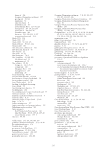137 15 A river and a livelihood – all but lost in a decade Pop Petersen Introduction I am passionate about the Culgoa River in the northern part of the Murray–Darling Basin, where we lived. For 27 years we managed Brenda Station, a 66 400 ha sheep and cattle property, straddling the Queensland and New South Wales border. The Culgoa River runs through the property for 52 km it not only supplied drinking water from its main channel, but its floods also sustained our livestock and our livelihoods. In the 1983 flood, the highest since 1890, we had 43 200 ha (74% of the property at the time) flooded for 13 weeks, producing amazingly productive pastures. Such large floods are rare but smaller floods regularly came, inundating different amounts of the property, excellent for our livestock breeding and production. Floodplain graziers, such as us, depend on these floods. When reliability of these floods went, we hurt economically, along with our environment. The Culgoa River is one of four rivers, including the Birrie, Bokhara and Narran Rivers, which spread out, forming the Lower Balonne floodplain in the northern part of the Murray–Darling Basin (see Chapter 14). They connect, forming a network of more than 1.4 million hectares of floodplain (Kingsford et al. 2004). They receive their water from upstream, from the Condamine and Balonne Rivers (see Chapter 14 Fig. 15.1). The Narran River fills the Ramsar-listed Narran Lakes and then overflows down a creek into the Bokhara River to eventually reach the Barwon River. Periodic flooding used to sustain a vibrant sheep and cattle industry, dry land farming and the environment. The floods brought economic benefits usually lasting three years. For example, we estimated that the 1995 flood provided about $36.1 million in income from cattle, sheep and dry land farming for the 236 properties on the Lower Balonne floodplain in New South Wales. This productive floodplain and its people were irrevocably damaged by the development of water resources upstream – a story that needs to be told by those affected. The development phase The rivers and their flooding patterns were altered forever by upstream development of the rivers. Beardmore Dam, built in 1972 on the Condamine River (Fig. 15.1), marked the beginning of a rapid expansion in irrigation upstream in Queensland. This took many of the floods that we needed for our income. The pace of this development picked up in 1995 when off stream water storages were built to capture river water amounting to 90 000 ML and increasing another 15 times to 1 500 000 ML by 2003. The policy of the Queensland Government continued to promote water resource development, which contributed to increased diversions by irrigators (see Chapter 21). They even converted the amount of
Downloaded from CSIRO with access from at 216.73.216.187 on Nov 17, 2025, 3:25 PM. (c) CSIRO Publishing

















































































































































































































































































